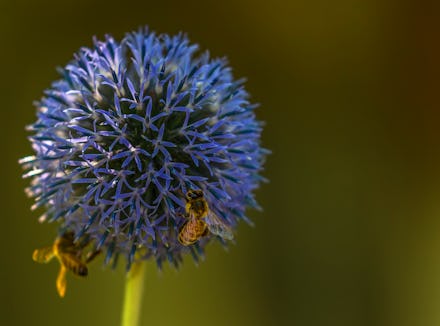Why winter is a surprisingly crucial season for bees

Honey bees are small insects that shoulder an enormous role in keeping our planet alive. They work together with other species to pollinate plants all over the globe, playing a large enough part that one study called honey bees the "most important single species of pollinator in natural ecosystems." But the honey bee population in the U.S. has been in decline for some years now. And just because we don't see bees in winter doesn't mean that number stops dropping.
Catherine Barry, Director of Marketing at the National Honey Board, discussed the wintertime bee colony losses with Mic. According to the organization's 'Bee Informed' survey — which takes data from thousands of beekeepers in America — there have been increases in winter colony losses over the past few years. Last winter, April 2018-April 2019, saw the highest losses in the survey's history at 37.7 percent.
"The rates of colony losses over the winter have varied from year to year," says Barry, "but we are seeing an increase over the last few years based on the Bee Informed Survey data." Previous losses in 2017-2018 were at 31 percent, losses in 2016-2017 were at 21 percent, and losses during 2015-2016 were at 27 percent.
The causes of these bee deaths vary. "Bee health decline has been linked to a variety of factors, including pesticides, pests and diseases, and forage and nutrition," Barry explains. These are problems bees struggle with all year long, but it's exceptionally difficult for the insects during winter because of "extreme weather and the colony’s reliance on stored food reserves."
Part of the difficulty can be pointed to climate change. As plants all over the world alter their growing to accommodate for the changing environment, food becomes harder to find. "Climate change affects bees by impacting the growing seasons of the plants they rely on for food," notes Barry. "For example, recent research found that a reduced flowering season decreased honey reserves for bees studied in the Mediterranean."
Another big part involves pesticides, which damage bee activities and harm the colony's efficiency. "[T]here is still much research to be done on the impact of pesticides on bee health," says Barry, but "recent research has shown that pesticides can impact memory and learning in bees." Bees rely on these skills to navigate their surroundings, remember flower locations, and report their findings back to the rest of the colony.
Preventing chemical harm to pollinating insects can face conflicts when pesticides are also used for public health and safety reasons. The National Honey Board — which represents U.S. beekeepers, honey producers and honey packers — along with other bee industry experts, has pushed for "communication and cooperation between applicators, growers, beekeepers, extension agents, and government officials to keep damage to honey bees caused by chemical exposure to a minimum."
Caring for the health of the bee population requires a lot of footwork and scientific studies. Bee health organizations like Project Apis m., the Pollinator Partnership, and the Honey Bee Health Coalition help create funding for "critical research that allows us to gain a better understanding of the issues impacting these insects," Barry adds. With climate change and pesticide use continuing to hit bee colonies, the research helps experts "educate beekeepers and farmers on hive management, pest management, ways to improve natural forage, and more."
It isn't just bee health organizations or beekeepers who can give honey bees a boost. Anyone can lend a hand to our six-legged friends. During cold months, you can help bees prepare for winter "by planting late-blooming, bee-friendly flowers," suggests Barry. "Bees spend the fall months looking for the last remaining bits of nectar in order to create the honey they’ll need to survive the cold winter months. By providing them with forage during this crucial fall time, you’ll help set them up for success once the temperatures drop."
Some bee-friendly, fall flowers include aster, goldenrod, and sunflowers. But don't pick just any flowers — choose flowers that are suitable for your local environment. There are planting guides available online for residents in the U.S. and Canada who might be interested in planting pollinator-friendly plants.
As the weather warms up and turns to spring, put a "shallow basin of fresh water with marbles or rocks in it" outside your house to offer the nearby honey bees a drink. The marbles and rocks will keep them from slipping into the water and drowning. Also consider reducing, limiting, or foregoing "the use of chemicals and pesticides to treat your lawn or garden while plants are in bloom." You can also try natural methods such as companion planting, which encourages growing different plants together to naturally repel pests and prevent the spread of plant disease.
For the folks who struggle to keep any plants alive, there are a couple other ways to contribute to the health of honey bees. Donating to bee health organizations helps fund additional research into preventing the loss of bee colonies. The National Honey Board, for example, uses five percent of its revenue each year to fund critical honey bee health research projects.
Buying honey at the supermarket also supports beekeepers that care for their hives. "Individuals do not need to purchase local honey specifically to make an impact," Barry says. "By enjoying honey in your favorite foods — whether it’s honey baked ham or a drizzle of honey in your favorite tea — you’re supporting beekeepers who are working hard to keep bees healthy during these crucial winter months."